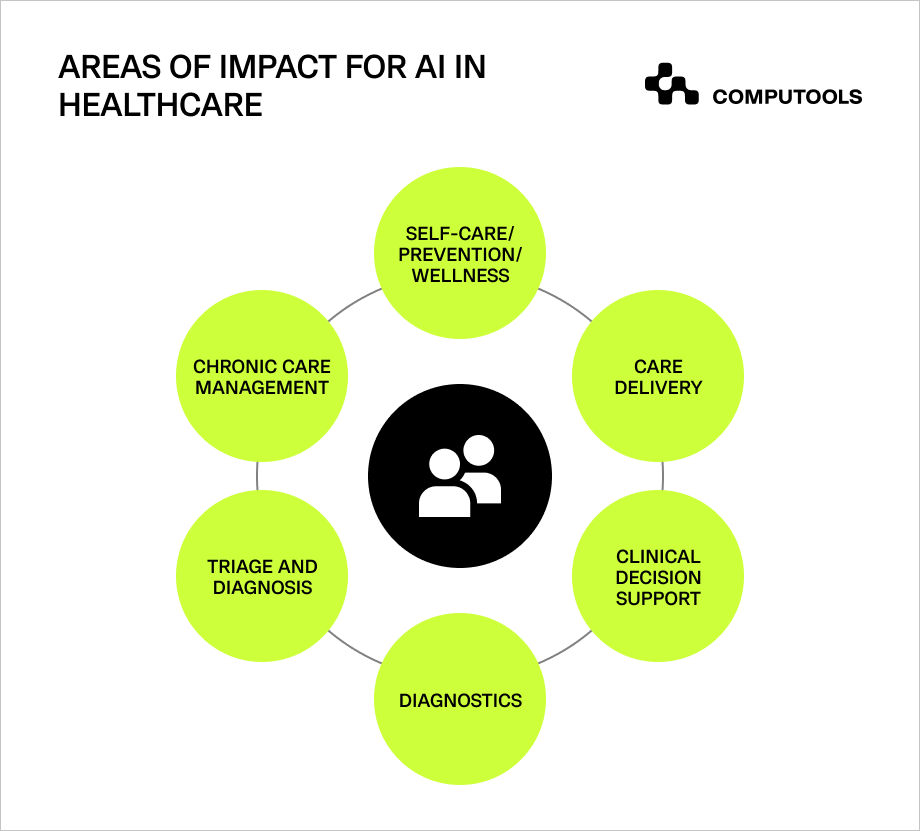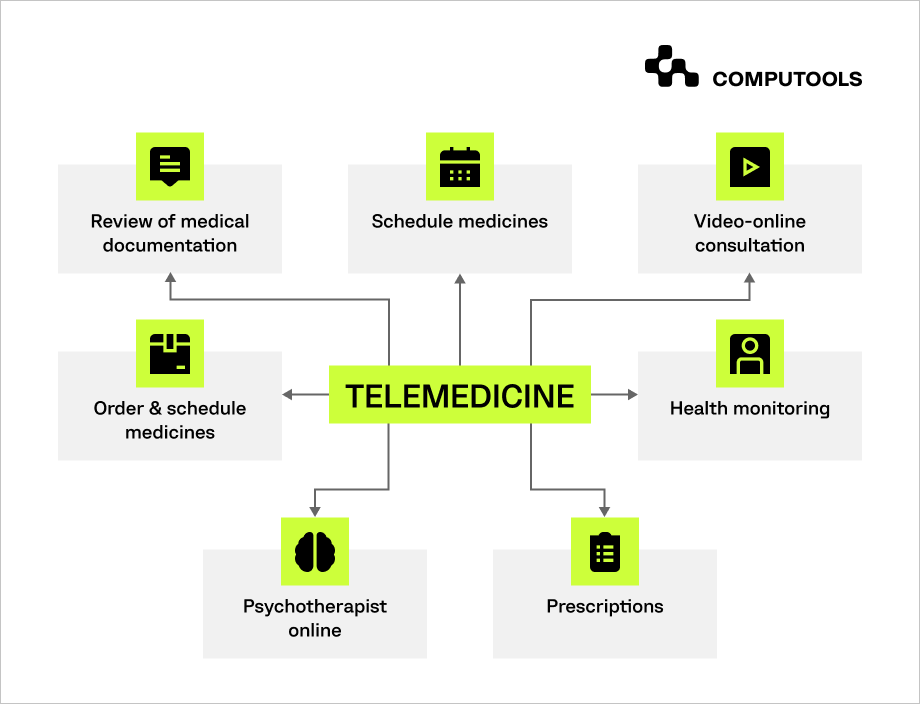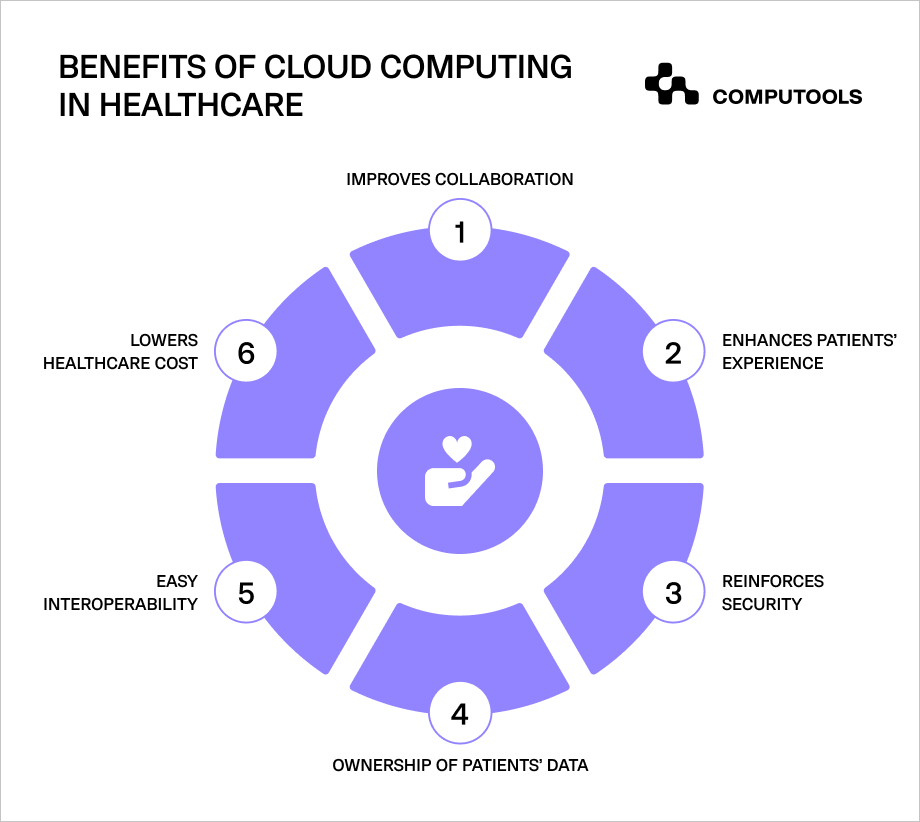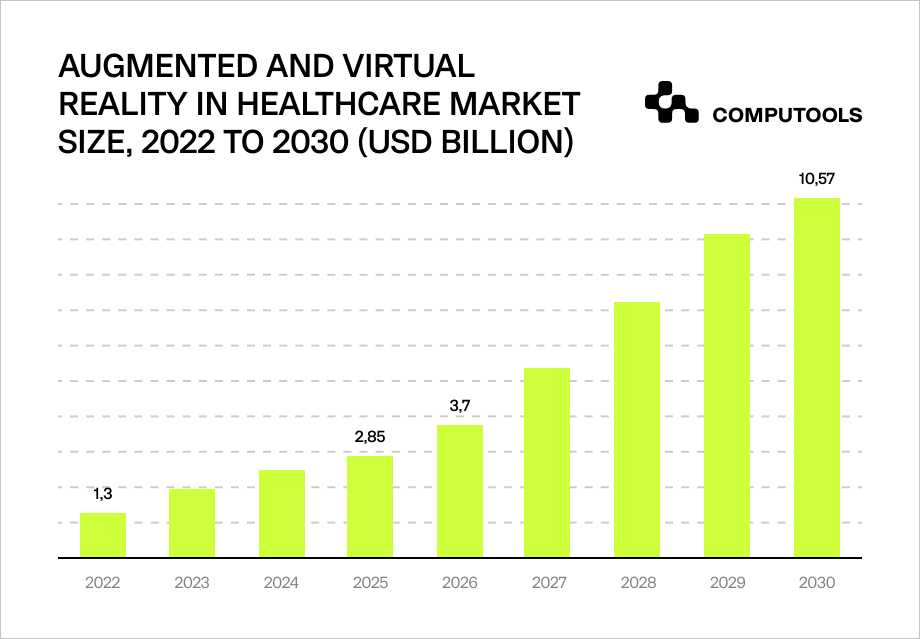As we step into 2024, it’s more crucial than ever to keep up with the healthcare technology trends.
While legacy systems remain essential for the day-to-day operations of hospitals and clinics, now is the time to consider seamlessly integrating them with emerging technologies or adopting more advanced solutions.
Today, we notice a giant increase in the global healthcare services market. It expanded from US$7.49 trillion in 2022 to US$7.97 trillion in 2023 and is anticipated to reach US$9.81 trillion by 2027, as stated by ReportLinker.
What fuels this significant growth? New technologies in healthcare not only help businesses tackle current challenges but also see a growing demand from consumers. HIMSS findings reveal an increasing desire among customers for technological innovations in the medical field.
The rising demand for digitalisation is a major factor pushing businesses to embrace technological solutions in healthcare operations. Staying aware of the latest technology trends is now a priority for each medical institution.
In this article, we’ll explore the latest trends in health technology, discussing the use of AI for medical solutions, digital twins models, professional wearables, smart implants, and more. Keep reading for fresh insights!
12 Latest Healthcare Technology Trends
1. Robotics
In today’s healthcare, a variety of medical robots are revolutionising the field, offering specialised functions to boost efficiency and patient care.
According to Global Market Insights, the medical robots market made over US$9.5 billion in revenue in 2022 and is predicted to grow steadily at a rate of more than 17.5% each year from 2023 to 2032.
Healthcare facilities are now using autonomous smart devices, like robotic nurses, to handle sanitation and supply tasks on their own.
These robots navigate through different areas within hospitals, contributing to numerous improvements.
• Surgical assistance robots play a huge role in minimally invasive and orthopaedic surgeries.
• Modular robots contribute to rehabilitation efforts, closely monitoring the progress of patients recovering from strokes or paralysis.
• Service robots handle logistical tasks, ranging from the preparation of patient rooms to the management of supplies.
• Social robots connect with patients and visitors, motivating them to follow treatment plans and offering mental support in long-term healthcare settings.
The integration of advanced medical robots and the broader application of robotics in healthcare is a huge transformative shift, promising not only increased efficiency but also better safety in healthcare practices.
2. Electronic Health Records
An electronic health record (EHR) is a digital version of a patient’s medical history, carefully maintained by healthcare providers.
This electronic file includes important administrative and clinical information crucial for individual care, such as demographics, identified problems, and prescribed medications.
EHR is currently the leading trend in medical technology, operating as a centralised hub for patient data and improving the management of information.
This innovation signifies a shift from traditional paper-based records to a more dynamic and interconnected approach.
The potential benefits of EHR implementation are significant, promising to improve healthcare delivery by boosting operational efficiency, reducing unnecessary redundancies and supporting data-driven clinical decision-making.
3. Artificial Intelligence
Recent years have witnessed rapid advancements in artificial intelligence (AI) technology, and this trend is expected to continue in 2024 and beyond.
AI is mainly used for detailed diagnostics and disease identification, but its applications extend beyond these areas.
• AI is applied in personalised medicine, tailoring treatments based on an individual’s genetic make-up.
• AI improves telemedicine by aiding in remote patient monitoring. This allows healthcare professionals to track vital signs without being physically present, ensuring timely interventions.
• AI is also helpful in medical imaging, where it interprets complex images like X-rays, MRIs and CT scans.
In essence, the growing use of AI in hospital technology shows improvements in operational efficiency within the whole healthcare delivery sector.

4. Internet of Medical Things (IoMT)
The Internet of Medical Things (IoMT) is a term covering a network of linked medical devices and applications that collect and transmit real-time patient data.
This includes:
• Wearable health tech: smart clothing, health patches and other wearables designed to monitor vital signs, physical activity and various health metrics
• Remote monitoring devices: gadgets capable of tracking blood oxygen levels, respiratory rates and sleep patterns for remote health monitoring
• Implanted medical tech: smart implants, insulin pumps and neurostimulators are embedded within the body and can transmit data, contributing to continuous monitoring and analysis
In short, the IoMT brings together a diverse array of healthcare technology trends, providing various applications for real-time health monitoring and assistance.
5. Digital Twin Technology
A digital twin is a computerised copy of the tools, individuals, operations and systems. In healthcare, these digital twins are employed to create computerised models of real-world patients, medical devices or even entire healthcare systems.
• Patient-specific digital twins capture and analyse health data in real time. This enables personalised treatment plans, predicts potential health issues and optimises care strategies.
• Healthcare facility digital twins model entire hospitals, simulating patient flows, optimising resource allocation and improving operational efficiency. This can be valuable in planning for emergencies or pandemics.
• Digital twins of biological systems are used in pharmaceutical research to simulate the effects of drugs on the human body. This accelerates drug development processes and helps in identifying potential side effects or interactions.
6. Telemedicine
Telemedicine is already a well-known healthcare practice. It uses technology to facilitate remote medical consultations and treatments, enabling patients to consult with healthcare professionals without needing in-person visits.
Telemedicine includes the following key aspects:
• Remote consultations help patients to connect with healthcare providers through video calls, phone calls or secure messaging. This is particularly useful for routine check-ups or discussing non-emergency health concerns.
• Virtual diagnoses and treatment healthcare digital trends allow doctors to prescribe medications, offer advice on managing chronic conditions and guide patients on lifestyle changes, all through virtual platforms.
• Better mental health support provided by telemedicine practices is particularly valuable, offering individuals the opportunity to receive counselling from the comfort of their homes. This is especially important during times of social distancing and lockdowns.
All in all, telemedicine offers better convenience, accessibility and flexibility in the delivery of medical services and is the most important trend of recent years.

7. Big Data Analytics
Big data is reshaping the healthcare landscape, introducing a transformative trend that stands out in the sector. As of now, the global big data analytics industry makes up about 14.2% of the healthcare sector, according to Fact.MR.
By utilising healthcare software development for handling large datasets, medical organisations can gain valuable insights through:
• Careful examination of patient records, medical images and genetic data to improve diagnostic accuracy and plan effective treatments
• Identification of intricate patterns and trends within healthcare data, enabling accurate predictions of disease outbreaks, patient outcomes and potential health risks
• Close monitoring of trends in population health, analysing epidemiological patterns, and designing targeted interventions for the prevention and management of diseases
8. Genomics
Genomics involves examining patients’ genetic compositions and identifying markers associated with diseases.
Advanced technologies, such as next-generation sequencing (NGS), enable a detailed analysis of an individual’s DNA, providing insights into their genetic make-up.
This information assists doctors in prescribing treatments specifically tailored to the patient’s genetic profile, minimising side effects.
Consequently, genomics opens the door to proactive measures, precise diagnoses and individualised therapeutic approaches.
By combining such technology trends in healthcare as genomics with EHR and big data analytics, doctors gain a richer and broader understanding of individuals.
This integration helps them delve deeper into genetic predispositions, allowing for personalised treatment plans.
9. Cloud Computing
Managing data in healthcare is quite complex. That’s why the adoption of cloud healthcare technology trends is growing rapidly, offering healthcare organisations the convenience of accessing data storage and powerful computing capabilities over the internet.
As per MarketsAndMarkets’ projection, the cloud computing market in the medical field is expected to reach US$65 billion by 2025.
Cloud computing is a crucial aspect of healthcare with various applications.
• Mobile health (mHealth) applications
Cloud platforms support the creation of mHealth apps, empowering patients for remote consultations and health monitoring, thereby improving the overall healthcare experience.
• Population health management
Cloud computing gathers and analyses diverse data sources for effective population health management. This assists healthcare providers in identifying trends, assessing demographics and implementing targeted interventions.
• Precision medicine and genomics
Cloud computing stores and analyses genomic data, facilitating personalised treatments based on individual genetic profiles.
These cloud healthcare technology trends are continuously evolving, expanding every day at an accelerated pace.

10. Blockchain
Healthcare extensively employs blockchain technology to protect sensitive patient information. Blockchain accomplishes this by encrypting patient records in a secure and tamper-proof manner, offering visibility and verification of data while safeguarding individual identities through advanced codes.
Being a relatively new technology in the healthcare industry, blockchain also creates a unified system, allowing providers to quickly retrieve accurate patient data, saving time and aiding in making informed decisions for diagnoses and personalised care.
Additionally, blockchain is changing how the pharmaceutical supply chain operates. It tracks the entire lifecycle of a drug, from where it starts to when it reaches the consumer, introducing an unparalleled level of transparency.
This means that every interaction with the drug is carefully recorded, including details about its environmental impact during shipping.
11. Remote Patient Monitoring
Remote patient monitoring (RPM) is becoming a popular trend in modern healthcare software development, offering continuous monitoring of patient’s health data directly sent to healthcare providers.
This is especially beneficial for high-risk patients, ensuring timely and effective healthcare interventions.
Here are some examples of the latest developments:
• Wearable devices are popular for continuous monitoring of vital signs, activity levels and sleep patterns. They offer a user-friendly approach to collecting real-time health data.
• Connected medical devices like Bluetooth-enabled blood pressure monitors provide a seamless way to transmit vital health data to healthcare providers, aiding in the management of chronic conditions.
• Remote monitoring systems for chronic conditions are designed for specific health problems, such as heart failure or COPD. These systems continuously monitor relevant indicators, offering proactive insights into patients’ health status.
12. Virtual and Augmented Reality
The increasing use of virtual and augmented reality (VR/AR) in healthcare is driven by their potential benefits. The global market for augmented and virtual reality in healthcare is expected to reach US$10.57 billion by 2030, according to Vantage Market Research.
As one of the emerging healthcare technology trends, VR finds applications in various medical areas, including therapies, education, surgical procedures and diagnostics.
Medical students use it to observe real-life surgeries, gaining confidence before practical training.
In its turn, AR overlays digital information onto the physical world, with a notable application in healthcare being diagnostic imaging.
By superimposing CAT scans onto a patient’s body, physicians gain a deeper understanding for more precise diagnoses.

Forecasting Healthcare Tech: Future Technological Developments
The future of healthcare technology is set to undergo significant changes, reshaping patient care and operational efficiency.
One significant shift is the further adoption of 3D printing, a technology that enables the creation of personalised implants and prosthetics, improving precision in medical treatments.
Surgeons already use 3D-printed models for better preoperative planning, improved surgical outcomes and more effective addressing of individual patient needs.
Another noteworthy future development is the rise of digital therapeutics, which marks a fundamental change in using software for evidence-based interventions in mental health, chronic diseases and rehabilitation.
Through mobile apps and software programs, more patients will receive therapeutic support, monitoring and feedback, contributing to scalable and personalised treatment plans.
As medicine increasingly relies on digital trends in healthcare, the importance of cybersecurity cannot be overstated.
Safeguarding patient data, securing medical devices and ensuring the integrity of health information systems are crucial for a robust cybersecurity framework.
This becomes even more critical with the shift towards interconnected networks and telemedicine solutions.
Collectively, these innovations promise a future healthcare landscape marked by better personalisation, more efficient treatment approaches and robust security measures.
Conclusion
In healthcare, the collaboration between medicine and technology is bringing about exciting progress. Key developments include the use of AI for diagnostics, incorporating IoT in patient care, and harnessing the transformative capabilities of big data analytics.
These trends signal a promising future for the healthcare industry. In a world where quick and effective patient assistance is essential, it’s crucial for healthcare providers to actively adopt the latest technology trends.
If you’re ready for a healthcare digital journey, contact us at info@computools.com.

Computools
Software Solutions
Computools is a digital consulting and software development company that delivers innovative solutions to help businesses unlock tomorrow.









“Computools was selected through an RFP process. They were shortlisted and selected from between 5 other suppliers. Computools has worked thoroughly and timely to solve all security issues and launch as agreed. Their expertise is impressive.”